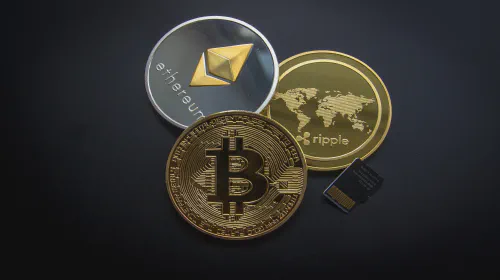What Is SushiSwap and How Does It Work?
Salomon Kisters
May 9, 2023This post may contain affiliate links. If you use these links to buy something we may earn a commission. Thanks!
SushiSwap is a decentralized exchange (DEX) based on the Ethereum blockchain. By nature, SushiSwap is an automated market maker (AMM) that uses its liquidity pool to facilitate trades. Created as a fork of UniSwap, SushiSwap has worked hard to build its own identity, and is currently going through a soft rebranding towards the name Sushi.
A decentralized exchange is quite different from centralized exchanges like Binance, Coinbase, and KuCoin. SushiSwap is owned by a community of users who share the decision-making power amongst themselves, whereas centralized exchanges are private companies that work more like traditional companies. Some people believe that a DEX is much more loyal to the ideology of the blockchain than a CEX, because it is owned and run by the people and independent of a central authority,
In this article, we will take a closer look at SushiSwap, its history, the technology behind it, and how it is impacting the larger blockchain industry.
What is SushiSwap
SushiSwap allows users to trade a variety of cryptocurrencies without the need for intermediaries or central authorities. Users of the platform trade against a liquidity pool rather than using traditional order books since the site employs an automated market maker (AMM) mechanism.
SushiSwap operates on a similar automated market maker (AMM) model as Uniswap, meaning that liquidity providers add funds to liquidity pools, which are then used to facilitate trades between different cryptocurrency pairs. Users can trade cryptocurrencies directly from their own wallets without the need for a centralized exchange.
Although it is based on Uniswap’s protocol, SushiSwap does a lot of things differently. Instead of Uniswap’s 3-tier reward system, it offers a flat fee of 0.3%. UNI tokens, even though rewarded to users at first, are no longer given out to liquidity providers. However, they are still regularly offered in SushiSwap’s system to people who stake their tokens. Apart from that, Uniswap’s tokens were distributed through an airdrop, whereas SushiSwap’s tokens were distributed through a more formal structure (Initial Exchange Offer).
SushiSwap’s website displays the running price of the SUSHI token, the total liquidity, total volume, and total pairs. It also shows a counter of the days since the commencement of Sushi. As of March 27th, 2023, it shows 943 days. SushiSwap is endorsed by well-known blockchain platforms like MetaMask, Polygon, zkSync, and BarnBridge.
Perhaps the best thing about using the platform is that SushiSwap places a lot of importance on user experience. The exchange has 400 tokens that are readily available to all users without the need for any sort of registration. It allows users to find the best exchange rate regardless of their network at a blazing-fast speed with no extra fees.
It also allows staking so that instead of lying idle, your money is working for you around the clock. In addition, SushiSwap encourages developers to actively take part to “help build the future with Sushi”.
History of SushiSwap
SushiSwap was co-founded in 2020 by a group of pseudonymous developers known as Chef Nomi, Sushiswap, and 0xMaki. The founders simply copied Uniswap’s base protocol (which is open-source and free-to-use) to lay the foundations of SushiSwap. To start off, they created their staking pool on the Uniswap platform. In return for staking their money, users would be rewarded with SUSHI tokens. Once their own platform was ready, they transferred the money to the SushiSwap liquidity pool.
The early days of SushiSwap were quite controversial, because one of the founders, Chef Nomi, took out 13 million dollars from the pool and disappeared. Many started to doubt the integrity of the platform after this incident. Amidst the crisis, the exchange’s control was eventually transferred to Sam Bank-Fried, who was also the head of Almeda Research at the time.
Fortunately, Chef Nomi later reimbursed the money and expressed regret to the public for their actions. Following the resolution of this crisis, the exchange resumed operations and started thriving under the leadership of Sam Bank-Fried.
What is the AMM Model?
The AMM model is at the heart of how SushiSwap operated. Since SushiSwap is a decentralized exchange, it does not have enough assets of its own to meet liquidity and exchange requirements. Thus, it uses participants in the network to provide liquidity. How does that work?
To provide liquidity in the SushiSwap system, a user has to deposit a collection of different assets into the liquidity pool. When another user initiates a trade, the exchange uses a mathematical formula known as the Constant Product Market Maker (CPMM) to calculate the exchange rate. The algorithm is based on the principle of supply and demand, and assumes that the product of the quantities of two tokens in a trading pair is constant. In other words, if the number of one token increases, the quantity of the other token must decrease proportionately to maintain the constant product.
For example, let’s say that a trading pair consists of Token A and Token B, and the initial quantity of Token A is 200 and the initial quantity of Token B is 300. The constant product of this trading pair would be 60,000 (200 x 300 = 20,000). If someone wants to buy Token A with Token B, they will have to pay an exchange rate that is calculated by the ratio of Token A to Token B in the liquidity pool.
If the person buys 10 units of Token A, the new quantity of Token A in the pool would be 210, and the new quantity of Token B would be 285.71 (60,000 / 210 = 181.82). The price of Token A would have increased, and the price of Token B would have decreased, because maintaining the constant product is necessary as per the rules of the algorithm.
How to Use SushiSwap
Using SushiSwap is a very simple and intuitive process, including the following steps.
Connect Your Wallet
The first step is connecting your wallet. You can only use a Web-3 wallet that has the ability to interact with smart contracts, so older wallets based on the Bitcoin architecture will not work. Popular wallets that work with the SushiSwap network include MetaMask, TrustWallet, and BraveWallet.
Depositing Assets
To begin depositing assets, you will be asked to provide the assets that the exchange can add to its liquidity pool. In return, you will be given liquidity tokens as proof of your stake in the network.
Trading
With the liquidity tokens in hand, you can then buy any asset on the network. The exchange rate is variable and is determined through the method we described above.
Withdrawing Assets
After you have completed your trading activities and have acquired liquidity tokens, you can easily convert them into the asset of your choice and withdraw them into your wallet.
Fragmentation in the DEX Market
As mentioned, SushiSwap was created through a fork in the Uniswap network. While it learned and applied everything that Uniswap had done till that point, SushiSwap started going in a different direction after a while by providing services that its community considered more useful.
The existence of the Uniswap and SushiSwap exchanges side by side, and many other AMM-based exchanges for that matter, means that users have more options and can exercise more choice. This is advantageous because it encourages competition and keeps exchanges working towards improving their technology and services.
However, the downside is that AMM-based protocols require a liquidity pool to function. Moreover, if the funds of users are spread too thin across the pools of different exchanges, it raises exchange rates and reduces the overall effectiveness of the exchange, thus adversely affecting the user experience.
If the AMM market fragments any further, it is highly possible that some of the less popular exchanges will have to bail out, since there is no other way to consolidate liquidity and continue to offer the best services to the end users.
Conclusion
SushiSwap is one of the most popular decentralized exchanges that have championed the AMM trading method in the crypto space. Over the years, it has successfully built a strong brand and following in the marketplace.
Although swapping currencies and staking them to earn more money is still their core competency, Sushi also provides streaming - a system that helps automate salaries. It also offers analytics capabilities to track the liquidity, volume, and fees generated by Sushi products.
Furthermore, the Sushi Academy helps “Demystify DeFi” for people, with three broad courses that cater to beginners, advanced-level users, and technical users. The academy helps users take up a more active role in the development and advancement of Sushi’s technology.
There is no other DeFi platform out there in our knowledge that does so much to integrate the community or offer revenue sharing this way - two things that set Sushi apart from its competitors.
Stay informed with the latest insights in Crypto, Blockchain, and Cyber-Security! Subscribe to our newsletter now to receive exclusive updates, expert analyses, and current developments directly to your inbox. Don't miss the opportunity to expand your knowledge and stay up-to-date.
Love what you're reading? Subscribe for top stories in Crypto, Blockchain, and Cyber-Security. Stay informed with exclusive updates.
Please note that the Content may have been generated with the Help of AI. The editorial content of OriginStamp AG does not constitute a recommendation for investment or purchase advice. In principle, an investment can also lead to a total loss. Therefore, please seek advice before making an investment decision.

Crypto Exchange Failures: A Deep Dive into Infamous Incidents [2023]
Discover how many crypto exchanges have failed over the years, causing financial losses and market instability. Dive deep into the infamous crypto exchange failures of all time.

What Is Binance and What Is It Used For?
If you're new to the crypto market and wondering what Binance is, you're not alone. In this article, we'll have a detailed look.

DeFi Tokens vs. Coins - What is the Difference?
DeFi is everywhere. But what are DeFi tokens, and how are they different from coins?
Protect your documents
Your gateway to unforgeable data. Imprint the authenticity of your information with our blockchain timestamp